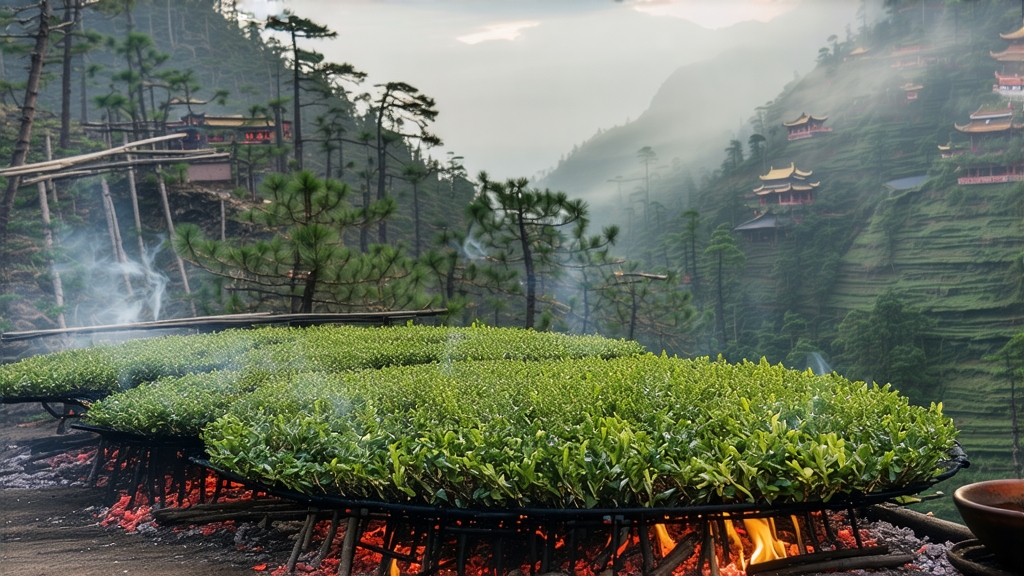
If every tea tells a story, Lapsang Souchong whispers legends of war, trade caravans, and mist-locked cliffs above the Min River. Discovered—some say by accident—during the late Ming dynasty (circa 1640) in the Wuyi Mountains of northern Fujian, this rugged black tea was the first to leave China in sizable quantities, sailing on Dutch East India ships and later perfuming the drawing rooms of London. If you have ever enjoyed a “smoky Earl Grey,” you have already met Lapsang’s descendant; bergamot was added to imitate the tea’s naturally tarry bouquet. Yet the original leaf is subtler, more elegant, and—when handled by skilled artisans—capable of depths that no flavoring can replicate.
Geography and Terroir
The Wuyi range is a UNESCO World Heritage site of vertical cliffs, running streams, and a micro-climate trapped between subtropical humidity and mineral-rich rock. Day-night temperature swings of 15 °C slow the growth of the tea bushes, concentrating sugars, amino acids, and aromatic oils. Two flanks matter most for Lapsang:
• Zhengshan (“Original Mountain”) – the 600–1,200 m core zone inside the national park where only a few villages, Tongmu most famous among them, may legally sell tea under the protected designation Zhengshan Xiaozhong.
• Waishan (“Outside Mountain”) – lower elevations and surrounding counties that follow the same cultivar (typically Xingcun or Cai Cha) but lack the cool mist and rocky soil. Their leaf is larger, smokiness often heavier, and price a fraction of the core.
Grades and Styles
Chinese merchants classify Lapsang along two axes: origin and finishing.
- Zhengshan Xiaozhong – unsmoked or lightly smoked, sometimes marketed as “fruit-scented” because the leaf carries natural notes of longan, lychee, and dried rose.
- Traditional Songzhong – the classic pine-smoke version, with three consecutive firings over fresh pinus massoniana logs.
- Wuyi Gongfu – a strip-style leaf harvested later in spring, given longer withering and tight rolling; designed for gongfu service in Russia and Central Asia.
- Jin Jun Mei – an offshoot invented in 2005 using only buds; no smoke, only a honeyed, malty sweetness that fetches prices rivaling top-grade Da Hong Pao.
Crafting the Smoke
Making Lapsang is a dance between wood, air, and timing. Picking starts in late April when two leaves and a bud still hold spring’s downy softness. The four primary steps are:
Withering
Bamboo trays are set above shallow charcoal pits in a loft called a qinglou. Heat is gentle (28–30 °C) so the leaf loses moisture without “baking.” After 8–10 h the edges turn chestnut and a faint fruit aroma appears.
Rolling
A 45-minute machine roll breaks cell walls, releasing catechins and polyphenol oxidase. Oxidation begins immediately; the leaf darkens from jade to copper.
Oxidation
Spread 3–4 cm deep in wicker crates, the leaf rests 3–4 h at 24 °C and 80 % humidity. Masters judge readiness by nose: a switch from grassy to apple-butter signals arrest.
Smoking & Drying
Here lies the signature. Pinewood is split, bark removed (it gives harsh resin), and stacked to semi-dry for two weeks. The first drying pass uses 80 °C smoke for 20 min; the second, called zuohuo, lowers temperature to 60 °C and lengthens exposure to 2 h. A third, optional bake over dying embers adds “cold smoke” that polishes the aroma. Throughout, the tea master balances airflow so leaves absorb phenols and guaiacol without turning acrid.
Chemical Alchemy
Gas chromatography shows that pinewood combustion releases syringol, 4-methylsyringol, and creosol—molecules also found in lapsang whisky and smoked bacon. When bound to leaf sugars they create a sweet-smoke impression distinct from the sharper hickory or mesquite notes Western palates know. Meanwhile, the Wuyi rock terroir supplies abundant linalool and geraniol, giving a hidden